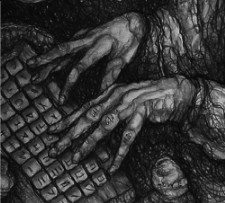Thus begins "Fish: A Melodrama in Five Parts," one of the twenty-three fictions contained in
"Sui Generis" and other fictions by Marc Lowe, an e-book soon to be released from ISMs press. This surreal image, reminiscent of Gregor Samsa waking up as a bug, is just one of many nightmarish, perplexing, and unsettling moments in this collection.
These fictions are not explorations of strange situations as such; the inexplicable doesn't need an explanation here. The unnerving quality of these fictions is different and deeper, sometimes in the most subtly disturbing ways. Be warned: many fictions end as ambiguously as they begin. What lingers in the readers' minds will be the quirky and at times borderline schizophrenic narrative voices, the well-paced and at times maddeningly logical construction of the tales, and the relentless intensity of the imagery.
This collection of fictions, composed while the author was living and teaching in Hiroshima, Japan, may call to mind the works of Kobo Abe and also Robbe-Grillet, Kafka, and Poe. Many of these fictions integrate a degree of philosophical speculation. Often there is a darkly humorous struggle as the narrator's seemingly keen intelligence is baffled by its surroundings. Take for example the title [meta-]fiction, a tale about a writer writing said tale where the fastidiously attentive narrator gradually betrays his own confusion while pondering Baudrillard's simulacra:
Though I do fancy Baudrillard's theories about simulacra in the philosophical sense, I don't take them literally, at least not to the extent that I would have assumed all four girls - five when putting the girl behind the counter into the mix - to have been actual manifestations of the same person, where the original model upon which the others were based would, herself, according to Baudrillard's exposition [as I understand it], have had to have been an image, a concept, an ideal…
Having read most of these fictions over the last several years in the various publications where they first appeared, online and in print, I can truly state these fictions bear up to re-reading. They are full of ideas and questions, clues and insinuations, vivid images, "jagged edges" and carefully constructed but unsolvable mazes. While they contain elements of noir and detective fiction, as a whole this collection conveys a distinctive quality all its own.
I will refrain, for instance, from hinting at the ending of "Eggshells." This unnerving creation at first wallows in the humdrum, but something whispers, ever so softly, that things are not what they seem; or rather, they
are what they seem and
are also something else. A similar fiction in the collection, "Strange Things," paradoxically reveals yet withholds its secret. There are constant metamorphoses here: from voice to voice, from character to character, from having solid ground under our feet to having the carpet yanked out from under us.
On occasion the prose takes on almost musical qualities, with a subtle tick-tock rhythm that diffuses the narrative action back into the mind(s) of the characters:
She got up from the bed. She was sweating profusely now. The room was hot like a factory. The air was thick with gray smoke. Why hadn't she noticed the smoke before? She began to cough. No matter. She needed the hammer. She opened the closet. The toolbox was there, beneath a stack of clothing. She opened it. She took out the largest hammer in the toolbox. It was heavy. She wondered how it would feel to be hit with the hammer. She wondered whether it would hurt very much. She wanted someone to hit her with the hammer. The hammer was very large. She put the head of the hammer into her mouth.
In this excerpt from "Jagged Edges", knowing exactly what is happening is beside the point; the fiction as a whole is painted as an abstraction, one off-key image/thought succeeding the next. While some fictions in this collection perfectly convey this sense of disorientation, in others, the action/narration includes very concrete twists and turns happening as fast as thought. For example, see "Time Bomb" where the story literally unfolds minute by minute. Several other fictions, including "Immaterial", have a futuristic, dystopian setting:
One might call the lady's shrunken head - though difficult to see on the screen - cute (in a perverse sort of way): her eyes are like two tiny probing buttons which dart to and fro, snapping open and closed while tracking the machine's wobbly needle as it stabs the spidery filaments of thread through the variously shaped swaths of cloth.
While certain themes run throughout, this collection features a variety of styles and settings, ranging from the playful but reflective seascape of "Anchor," to the backwoods grotesquery of "The Tree Cutter," to the ultimate primal scream embodied in "Re-Birthing":
…before it's all over/begun, all of the images and the sights/sounds/ smells/tastes/touches that he has ever experienced or read about or dreamed about all congeal into one final, unresolved, resounding question that has/will torture/d him for eternity, the question that preceded/followed his inception and has/will never ever go away, the question that can never in a million years be answered because it is intrinsically unanswerable, undoubtedly, undeniably unreasonable…
What was the question? I won't give it away, but believe me -- it's one we all ask. This fiction, one of the strongest in this collection, is one of the most memorable nightmares I never had.
Go to "Sui Generis" and Other Fictions

